Vinyl flooring is considered to be one of the easiest to maintain flooring options on the market. There are a few tips and tricks to learn that will help you spend less time cleaning your floors. For a quick run-down, read our quick vinyl flooring maintenance tips below or watch this video from worldwide vinyl supplier Armstrong.
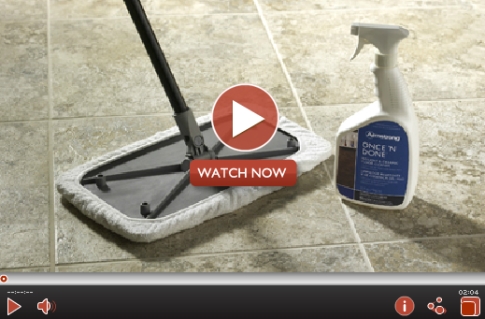
Maintenance tips
- Sweep your vinyl flooring regularly – at least once per week.
- Wipe up spills as soon as possible to prevent staining.
- When sweeping is not enough to get your floors clean, occasionally wash your floor using the manufacturer’s recommended cleaner. Do not use detergents, abrasive cleaners, mop and shine products, paste wax or solvent based polishes.
- Use a mop or cloth to clean your floor. We do not recommend using a vacuum beater bar or abrasive scrubbing tools as these can damage your floor.
- If your floor begins to dull over time, use the manufacturer recommended floor finish polish to restore the floor’s original shine. The gloss level of each vinyl floor varies, so it’s important to check what your manufacturer recommends.
Preventative maintenance
- Use a walk-off mat at outside entrances to prevent dirt, sand and grit from being tracked onto your vinyl floors. Rubber or latex backed mats can stain your floors. Instead choose a non-staining vinyl mat or a woven colourfast rug.
- When moving appliances or heavy items, put down a piece of plywood or hardboard runway to protect your floors from damage. A runway is always recommended, even when using a furniture dolly or items with wheels.
To inspire your decor related new years resolutions, we have rounded up 2015 colour trends from our favourite colour experts. This is the final post in a three part series featuring trends from Pantone, Shaw Floors and Benjamin Moore.
Guilford Green
Since paint companies are always on the pulse of the latest colour trends, we turned to Benjamin Moore to see their recommendations for 2015. The Benjamin Moore team picked a beautiful palette of twenty three blue, green, blush and berry shades for 2015. From that palette they narrowed it down to their colour of the year, Guilford Green. Benjamin Moore Creative Director Ellen O’Neill describes it as “a neutral that’s natural. A silvery green that works with, well, everything.” Guilford Green is part of the Benjamin Moore Historic Collection. The collection is a timeless and elegant set of hues inspired by the documented colours found in 18th and 19th century architecture.
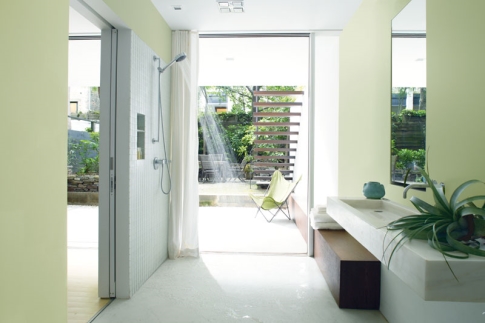
Benjamin Moore
Guilford Green creates a sense of tranquillity in this bathroom when paired with white tiles and elements of nature.
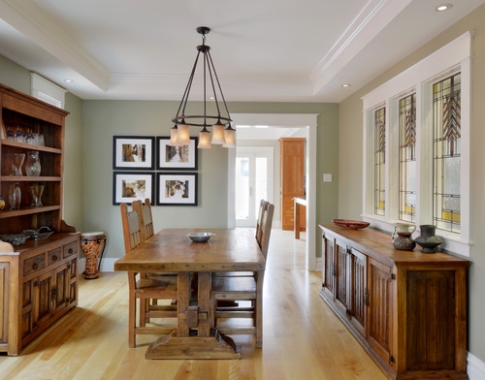
Houzz: Chuck Mills Residential Design & Development
Guilford Green was the perfect choices to pull together the many wood tones in this dining room. The greyish brown undertones complement all wood tones well.
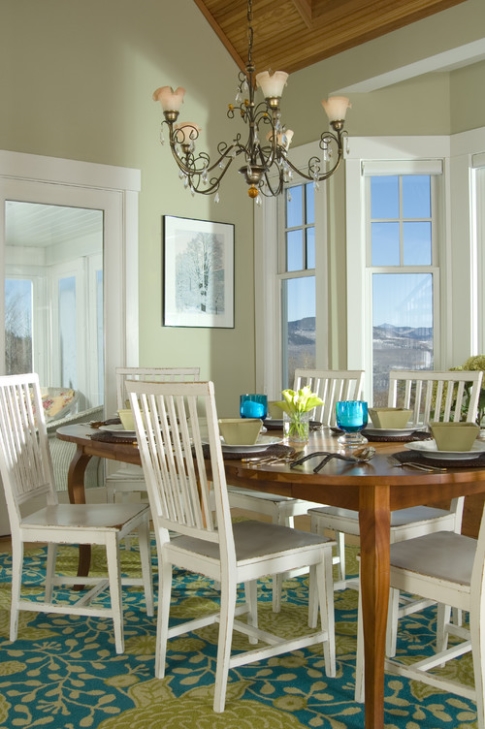
Houzz: Edwina Drummond Interiors
Jazz up this neutral green by pairing it with a bold accent colour like turquoise.
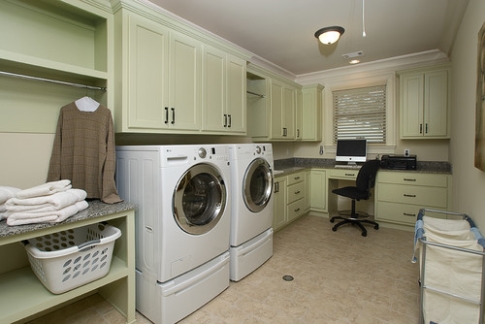
This colour is suited to more than just walls. Painting the cabinets Guilford Green keeps the laundry room from looking dull. Other furniture like a dresser or a bar cart would also look great painted this colour.
View other posts in the 2015 Colour Trends Series
Part one: Pantone’s 2015 Colour of the Year Marsala
Part two: Shaw Floors River Thames Taupe
Posted on Jan 6 2015 10:31 am by Kelsey Shipley
|
category: Renovation Design Tips |
1 Comment
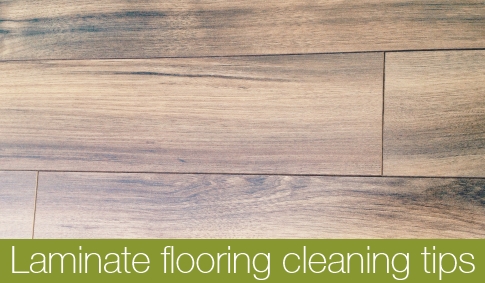
Proper cleaning and maintenance is the key to keeping any flooring pristine. While laminate flooring is great for standing up to tough household conditions, it needs routine maintenance. To clean any flooring, we always suggest checking the manufacturer recommended cleaning products and methods. We have a few helpful laminate flooring cleaning tips to keep your floors in great shape.
Routine Laminate Floor Cleaning Do’s
- Clean up spills immediately using a cloth or sponge. Liquids should never sit on your laminate floors.
- Only use cleaning products designed for laminate flooring care. For the best cleaning results and to ensure warranty coverage, use the cleaner specified by your manufacturer.
- Sweep or dust the floor regularly to remove dirt and grit that can damage your the laminate’s finish. Vacuum’s with a hard floor attachment can also be used. Vacuum beater bars are for regular use.
- Use a dry microfibre mop for cleaning after sweeping or vacuuming. Spray the recommended laminate floor cleaner on it until the mop is damp. Mop away.
- Put down entry mats to prevent dirt, grit and other unwanted substances from being tracked onto the floor.
Routine Laminate Floor Cleaning Don’ts
- Do not wash or wet mop laminate floors with any liquid cleaner. This includes soap, water, detergents and any strong ammonia or chlorine based cleaners. The moisture can cause swelling, warping or delaminating.
- To maintain your warranty, do not use steam mops. Flooring manufacturers do not want the steam mops used on their laminate flooring. The moisture from the steam mop can be too much for laminate.
- Avoid using steel wool, scouring pads, abrasive cleaners, waxes or polishes.
Posted on Jan 4 2015 1:49 pm by Kelsey Shipley
|
category: Flooring Guides Laminate Flooring |
5 Comments
We are welcoming the upcoming new year by sharing 2015 colour trends forecasts from our favourite colour experts. This is part two of a three part series featuring colour trends from Pantone, Shaw Floors and Benjamin Moore.
River Thames Taupe
For this colour trend, we look to the Shaw Floors 2015 Colour Forecast. As the world’s largest carpet manufacturer, Shaw Floors is at the forefront of of all home decor and colour trends. River Thames Taupe is our favourite of the four colours Shaw predicts will be big for 2015. We love the versatility of this neutral that blends the once trendy beige tones with today’s popular grey shades. We gathered pictures of a few interiors that show off the endless possibilities of River Thames Taupe.
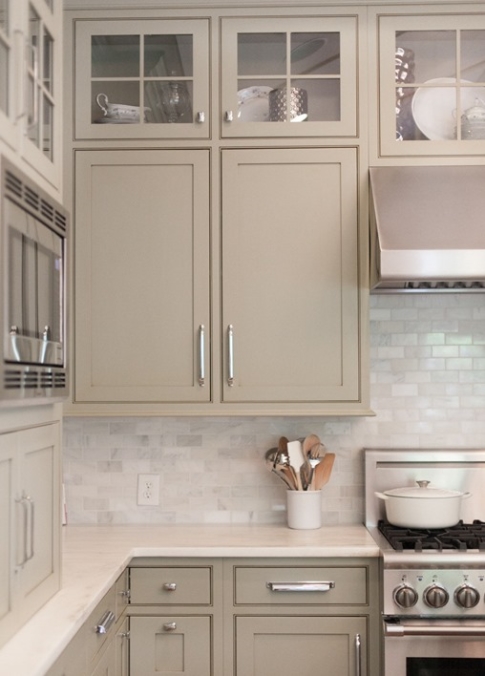 Style Me Pretty: Laura Hollingsworth Home Tour by Cheryl M
Style Me Pretty: Laura Hollingsworth Home Tour by Cheryl M
Greige and taupe shades are a refreshing change from the ubiquitous plain white cabinets. These neutral hues make the kitchen feel warmer and more elegant.
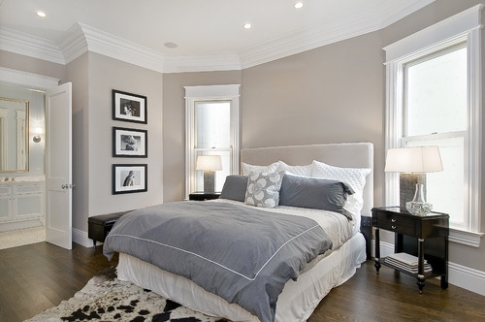 Houzz: Cardea Building Co
Houzz: Cardea Building Co
Using taupe on the walls in this master bedroom channels the vibe of a peaceful retreat.
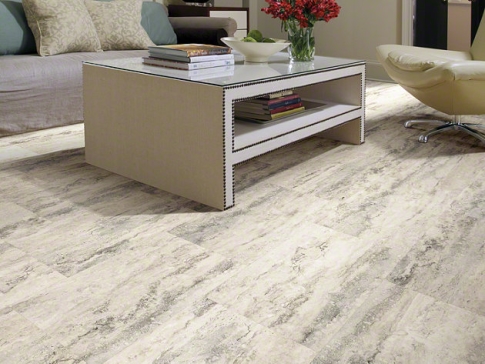 Shaw Floors Luxury Vinyl Tile Newport Beach colour Pier
Shaw Floors Luxury Vinyl Tile Newport Beach colour Pier
Neutrals like taupe are popular colour choices for flooring and there are an abundance of taupe options available. This click together 12×24 luxury vinyl tile option would look great in any room in your house.
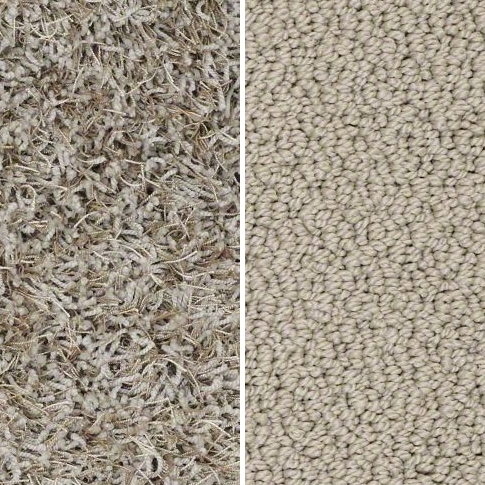 Shaw Carpet Bling / Shaw Carpet Timeless Charm Loop
Shaw Carpet Bling / Shaw Carpet Timeless Charm Loop
Taupe is a classic colour option for any style of carpet. Try a textured multi-tonal frieze as an area rug in the living room or a cushy loop carpet for a neutral wall-to-wall carpet in bedrooms.
Shaw Floors has even more taupe hued inspiration for you on their River Thames Taupe Pinboard.
Follow Shaw Floors’s board “River Thames Taupe” – Shaw Color Forecast 2015 on Pinterest.
View other posts in the 2015 Colour Trends Series
Part one: Pantone’s 2015 Colour of the Year Marsala
Part three: Benjamin Moore’s Colour of 2015 Guilford Green
Posted on Dec 30 2014 11:38 am by Kelsey Shipley
|
category: Renovation Design Tips |
3 Comments
To say goodbye to 2014 and welcome in the new year, we are sharing a few 2015 colour trends forecasts from our favourite colour experts. Whether you’re planning a whole home renovation or just looking for a few new accent throw pillows, these colour choices can help inspire your design choices this year. This is part one of a three part series with 2015 colour trends forecasts from Pantone, Benjamin Moore and Shaw Floors.
Pantone colour of the year: Marsala
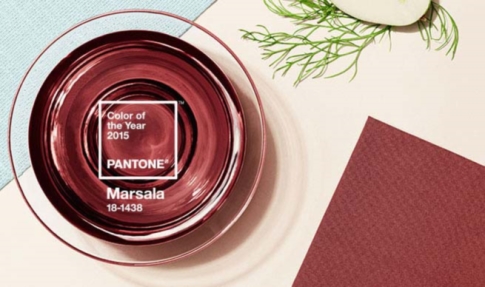
The Pantone Colour Institute chooses their colour of the year based on a thorough examination of fashion trends, art, film, cars and general culture around the world. The selections over the past few years tended to be bold and best suited for accent colours in interiors (see 2014’s Radiant Orchid and 2013’s Emerald). While we may see Marsala popping up as a trendy colour for clothing and nail polish in 2015, we are less likely to see entire walls painted in this colour or an increased popularity in this hue of broadloom carpet.
Pantone describes the 2015 colour of the year Marsala as a “naturally robust and earthy wine red.” This reddish-brown hue has an elegant and satisfying warmth that could work well in the colour palette of many interiors. We gathered a few examples of trendsetting homes where Marsala-like hues are already full-force.
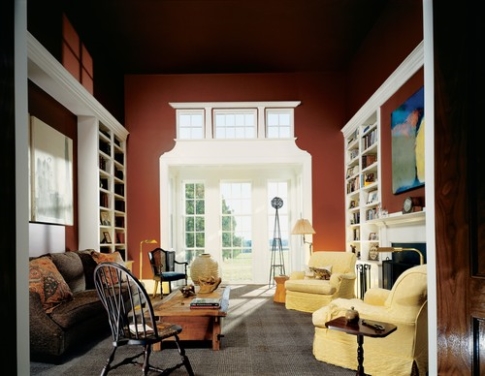
Houzz: Ike Kilgerman Barkley Architecture
The Marsala paint colour used on the walls of this book-lined living room adds a touch of warmth. The contrasting white woodwork creates a clean look and keeps Marsala from looking too earthy.
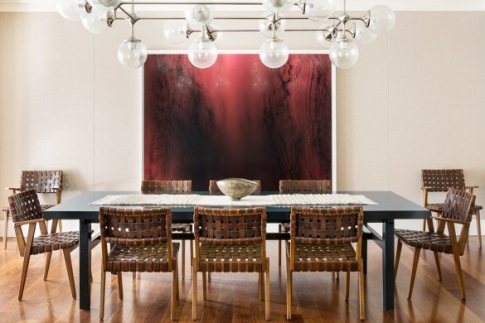
Domaine Home
Marsala hues in this artwork create a dramatic and colourful focal point in this dining room.
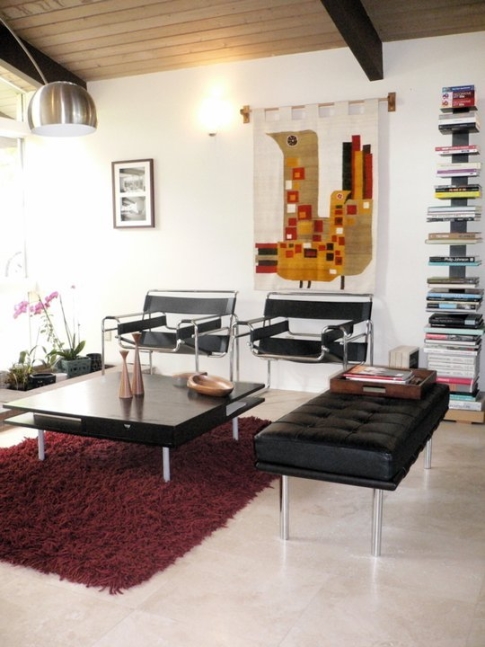
Apartment Therapy: LA House Tour
Marsala looks best when used with textures like this shaggy rug. Try using the colour of the year for other textures like linens or leather.
For another dose Marsala inspiration, visit our Marsala Colour Trend pinboard.
View other posts in the 2015 Colour Trends Series
Part two: Shaw Floors River Thames Taupe
Part three: Benjamin Moore Guilford Green
Posted on Dec 16 2014 11:16 am by Kelsey Shipley
|
category: Renovation Design Tips |
2 Comments








 Houzz: Cardea Building Co
Houzz: Cardea Building Co




